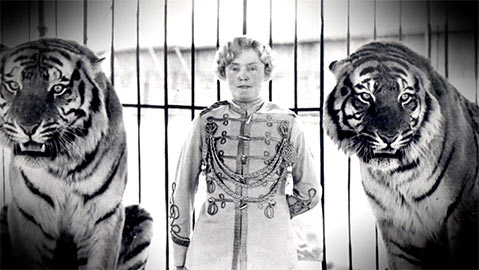Mabel Mabel Tiger Trainer
Director Leslie Zemeckis

Mabel Stark was known as Mistress of the Tigers, so adept was she at training the big cats. Born in 1889 into squalor, Stark raised her station in life by learning to tame tigers; by the 1920s she was renowned in her field, travelling throughout the U.S. with the circus. In Mabel Mabel Tiger Trainer, director Leslie Zemeckis give us a peak into Stark’s fascinating world that included several marriages, fame, and multiple maulings by the tigers to which she was so devoted. Her love for the animals ran so deep, in fact that despite having “had my arms broken, my legs broken, part of a deltoid muscle torn out of my right shoulder, a plate in my head, my elbow is gone out of my right arm…no flesh on my legs,” Stark stated her only wish was “to be killed by my animals.”
See lesliezemeckis.com.
How did you come upon this topic? Was it tiger training you were looking into first or did you come across Mabel Stark and then follow her life? I have spent about 15 years researching early 20th century forms of entertainment, with a special expertise on burlesque. I came across Mabel’s story while doing research a while back. She actually worked briefly in the “cooch” show before going on to train tigers. I found it interesting on many points: she was an independent woman who took up training the tigers after being told, “no woman could train tigers.” She fell in love with the animals and absolutely devoted her life to these “stripes,” as she sometimes called them. Nothing got in the way of her care for them. I thought it would be a story about bravery, but ultimately it’s a story of love.
What surprised you the most while you were making the film? That it wasn’t bravery it was love that drove [Mabel] — and all the animal trainers I researched and interviewed and followed on the circus route today. Though mauled many times she — like the rest of the trainers — never blamed the cats. It was always the trainer’s fault.
The film was chock-full of historic information. How long did it take you research the subject matter? Three to four years. And I’m still researching. The circus is so filled with history and importance to American culture and entertainment. I never leave a subject once I start it.
Life with the circus seemed so rough, but Mabel was able to find a place for herself there. How do you think she managed that considering woman had so little influence at that time? It was absolutely so much work. So hard, on the road. But she found family and acceptance there, where she had none before. Historically it was either a place where you were born into a circus family or you ran away and joined one, finding your own place in the world.
The circus was a different world, once she established her act and that she could work with the cats, she had a place. She was the one studios went to to double for films. She doubled for Mae West and others. She forged her way completely on her own terms. She wouldn’t take any b.s. from anyone. She didn’t do it for fame or glory. She worked with tigers because she was passionate and had found purpose. And when that was taken away . . .
What do you hope audiences take away from this film? That Mabel loved these animals. She was an interesting woman. The circus had and has value. We absolutely will lose animal acts in the circus — which I think is tragic. The circus is entertainment and education. And you can still go today and be thrilled and amazed.
What’s your next project? I am working on a sizzle reel for my next possible reel, on some women in the 1860s (I keep going further back in time), and writing another book on two burlesque superstars. And managing my burlesque site ( theburlyq.com) to bring the burlesque community together.



